On November 8, 2017, I was presented with the Leonardo da Vinci World Award of Arts which is conferred by the World Cultural Council (WCC). The award ceremony was held at Leiden University in the Netherlands and many dignitaries were in attendance including Sabine Nölke, Canadian Ambassador to the Netherlands.
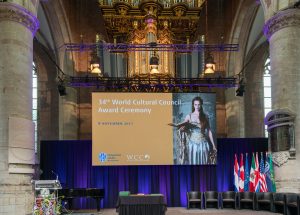
WCC Award Ceremony at Pieterskerk, Leiden University.
The World Cultural Council is an international organization based in Mexico and seeks to promote tolerance, peace, and fraternity by encouraging the use of science, art, and education to further the wellbeing of humanity. Since 1984 it has awarded prizes in Science (the Albert Einstein annual award) and in Art or Education (the Leonardo da Vinci and José Vasconcelos biannual awards) “to outstanding figures who have enriched our cultural legacy through their respective discipline and serve as inspirational examples for future generations.”
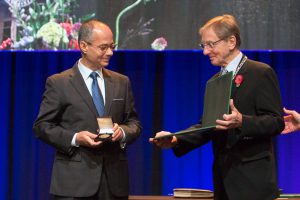
Prof. Omar M. Yaghi accepting the Albert Einstein World Award of Science from Sir Colin Blakemore.
The recipient of the Albert Einstein World Award of Science this year was Omar Yaghi, Professor of Chemistry at the University of California-Berkeley. He was recognized for his original accomplishments, both theoretical and experimental, that have spurred the creation of a new field of chemistry called Reticular Chemistry. In his research, he has developed new materials for application in clean energy, hydrocarbon emission, clean water production, catalysis, and more recently, electronics. Previous winners of the Albert Einstein Award include many Nobel laureates.
The Leonardo da Vinci World Award of Arts is not always awarded to a musician. On their website, the WCC states the Leonardo da Vinci Award “is an acknowledgment to those who lift our existence to a higher level by the beauty or inspiration of their creative talent. It is conferred on a renowned artist, sculptor, writer, poet, cinematographer, photographer, architect, musician or other performing artist, whose work constitutes a significant contribution to the artistic legacy of the world.” I was surprised and pleased to see that visual artist Robert Rauschenberg was the 1995 recipient of the Leonardo da Vinci Award.
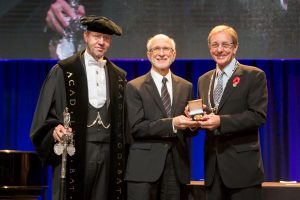
Accepting the Leonardo da Vinci World Award of Arts medal from Sir Colin Blakemore.
The award ceremony was held in the famous Pieterskerk at Leiden University, the oldest university in the Netherlands. Presenting the awards were Sir Colin Blakemore, President of the WCC, Rector Magnificus Carel Stolker of Leiden University, and Professor Mark Rutgers, Dean of the Faculty of Humanities at Leiden University. As part of the award I was presented with a diploma and a commemorative medal featuring the likeness of Leonardo da Vinci.
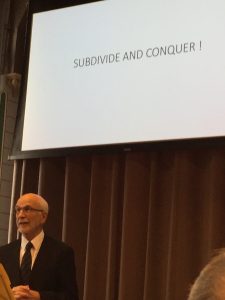
Subdivide and Conquer lecture topic.
On the morning of the award ceremony, Professor Yaghi and I each presented a lecture. Mine was titled “Subdivide and Conquer: A Quest for the Hidden Beat.” In my talk, I examined the theory behind the rhythmic patterns of Steve Reich’s Drumming and Clapping Music, and compared the structure of these rhythms with an analysis of the bell patterns in the West African Atsiagbekor drum ensembles. Professor Yaghi’s lecture was titled “Reticular Chemistry: The Journey to Beautiful and Functional Porous Crystals.”
Since my award was named after Leonardo da Vinci, I decided to do some research on the great Renaissance polymath. I first read Charles Nicholl’s biography Flights of the Mind. Then, coincidentally, the Walter Isaacson biography titled Leonardo da Vinci was released just a couple of weeks prior to the award ceremony. I discovered by reading these biographies that Leonardo was supposedly an excellent musician and even designed some percussion instruments. This is a page from one of Leonardo’s sketchbooks with drawings of drums and even a short melody, all written in his habitual, right-to-left ‘mirror-script.’
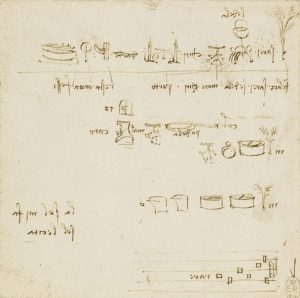
Leonardo’s sketches of percussion instruments; Royal Collection Trust/© Her Majesty Queen Elizabeth II 2017.
If you listen to my speech you will hear that I made some comparisons with Leonardo and percussionists of today. To view the presentation of the award, go to this link:
https://www.dropbox.com/s/dknhpuvqjkfggi4/2017%20Leonardo%20da%20Vinci%20Award%20of%20Arts%20-%20Russell%20Hartenberger.mov?dl=0
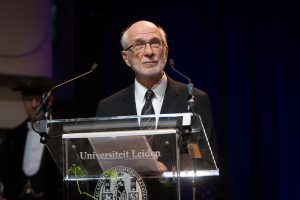
My acceptance speech at the WCC award ceremony.
My whole experience in Leiden was made particularly special because my wife, Bonnie Sheckter, and my two daughters, Laura and Carla, were there with me to share in the celebration.
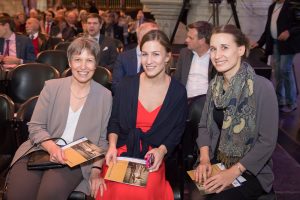
Bonnie, Carla, and Laura.
WCC award winners included Special Recognition Diplomas to nine women from Leiden University who excel in various areas of research. Of particular interest to me was the work of Victoria Nyst, who studies sign languages used by deaf communities.
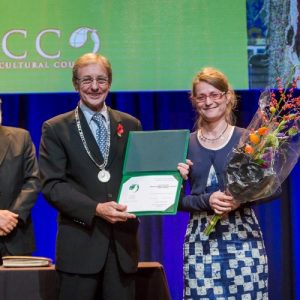
Victoria Nyst accepting her Special Recognition diploma from Sir Colin Blakemore.
Contrary to what many people think, there is no such thing as a universal sign language. Ms. Nyst’s main focus is on deaf communities in Ghana and other African countries, and she told me she is currently learning Ewe in order to help in that Ghanaian community.
To view the entire WCC awards ceremony, please go to this link:
https://www.universiteitleiden.nl/en/dossiers/world-cultural-council/live-video
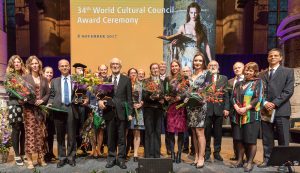
WCC award winners.
